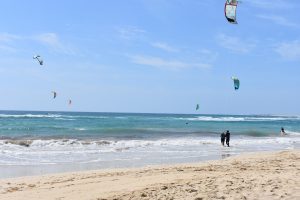Sal island is characterized by extensive white sand beaches and crystal clear waters, associated with climatic conditions (sun, wind, currents and strong waves). These natural conditions are excellent resources for the practice of sun and beach tourism and water sports (surfing, windsurfing, kitesurfing, diving, swimming, sport fishing and boat trips). In addition to these, it also presents excellent conditions for ecotourism, nature tourism, exploration of the beautiful coasts and hidden treasures of the island, and business tourism and events (fairs, congresses, celebrations, weddings, honeymoons, among others).


Sal island has a warm and dry tropical climate, characteristic of the Cape Verdean archipelago, that is located in the region of sub-Saharan Africa, located between the Sahara desert and the humid tropical region to the south. This area is called Sahel, an arid strip passes through 12 countries, Senegal, Mauritania, Mali, Burkina Faso, Niger, the northern part of Nigeria, Chad, Sudan, Ethiopia, Eritrea, Djibouti and Somalia. The climates of this zone are characterized by a long dry season, interspersed with a period of only three humid months, during which the rains are concentrated in a few days.

Cape Verde has a warm, arid and semi-arid climate, strongly marked by the trade winds that blow from the Northeast. Despite the arid climate, the constant breeze blows down tropical temperatures.
Temperature
Temperatures vary little throughout the year. The maximum temperature is between 25ºC and 30ºC (77°F and 86°F), while the minimum temperatures vary between 18ºC and 25ºC (64.40°F and 77ºF). The hottest months are August, September and October, with 29 ºC (84.20°F) of average temperature while the coldest are January and February, with around 20ºC (68°F) of average temperature. The remaining months have a mild temperature, with days of radiant sunshine.
Like all Sahelian areas, Cape Verde has two contrasting seasons: the rainy season and the dry season or the breezy weather.
The rainy season runs from August to October, and the Sal island, being flat, does not benefit from much rainfall. With little rain, usually a rainy day, for a short period of time, followed by a day of radiant sunshine. The driest season runs from December to July.
The sea water temperature varies between 21ºC (69.8°F) in February and March and 25ºC (77°F) in September and October. Cape Verde’s climatic stability guarantees the possibility of tourism all year round.
Precipitation and atmospheric moisture
Despite its volcanic origin, Sal island is essentially flat, with long beaches of fine white sand.
The relative humidity in Cape Verde varies between 60% during the day and 90% during the night or during periods of cloudy skies and precipitation. The highest values occur in the months of July to October, being able to exceed 95% and the minimums reach 59% registered in the month of March.
The national average air temperature has a low thermal amplitude, with the average annual value varying between 8ºC and 10°C (46.40°F and 50ºF). On Sal island, the average annual temperature values is 25.1 ° C (77.18°F). The average annual rainfall on the island does not exceed 80 mm.
Wind
The blowing of the wind is a constant on the islands. During most of year is mild and from October to June the Harmattan blows, a dry and dusty wind from the Sahara, which carries the Sahara sand that annually causes a kind of fog known as “dry mist”, which can severely limit visibility, with consequences for air and maritime navigation.
The blowing of the wind is a constant on the islands. During most of the year it is a mild wind and from October to June it can blow the Harmattan, a dry and dusty wind from the Sahara, which carries the Sahara sand for a few days and causes a kind of mist known as “mist drought”, which can limit visibility and flights on some islands.


From October to March the wind is more intense, which allows the practice of nautical sports (windsurf, kitesurf, etc.)


